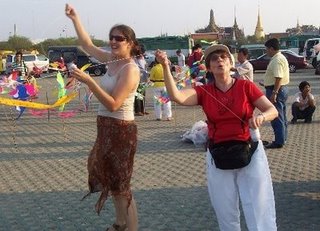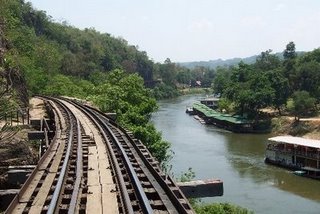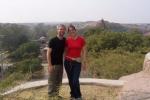
Katlijn and her mom flying kites in Bangkok.
Katlijn's mom, Chris, and Chris' childhood friend, Emmy, flew all the way from Belgium to join us on our three week exploration of South Thailand. As they are both Dutch-speaking, mothers, and diminutive in stature, we affectionately referred to them as "the mammatjes" (meaning "little mommies"). For our part, we enjoyed their company immensely. For their part, they let us take the lead and temporarily turned the tables on their former roles as parents.

Chris and Emmy: little people on a big adventure.
Our first days together generally consisted of gorging ourselves on Geert's complimentary buffet breakfasts followed by languishing about in Bangkok's smoggy heat. During this time, we introduced the mammatjes to some of the city's redeeming qualities: Thai food, 200 Baht foot massages, and Starbucks coffee. However, it soon became apparent that getting out of Bangkok as soon as possible was in everyone's best interest.

Statue and the grand palace gold glistening in the heat of the day.
 
Scenes of the Damnoen Saduak Floating Market.
Our first attempt was to rent an air-conditioned car and visit several nearby attractions including the Bridge on the River Kwai: a site made famous by David Lean's memorable war epic. We caught a ride on the historic "death railroad" while Emmy entertained the local passengers who much appreciated her zany style of humour.

The "death railway", built by laborers and POWs during World War II, provided a vital supply line linking Thailand to Burma where the Japanese waged war against the British Empire. It is estimated that 16,000 allied prisoners and as many as 100,000 labourers died of malnutrition and disease during its construction.

While the bridge does exist, and Alec Guiness unforgettable in his portrayal of the quintessential British officer, the film is otherwise fictional. The real bridge was bombed by the allies along with hundreds of prisoners placed on the bridge as a deterrent by the Japanese. The current structure is a re-construction.
Nowadays, the infamous bridge is a tourist circus and the nearby museum comically inappropriate. Housed in a dingy concrete building is a bizarre assortment of random junk accompanied by uninformative explanations gushing over Japan's engineering genius and their alliance with Thailand during World War II. The best part is the hilarious butchered English which reads like a dramatic war novel written in baby-speak. A ridiculously grizzly exhibit featuring dead body parts floating down the water has the caption "after allied bombing of the bridge, bodies lay about in the river all higgeldy-piggeldy". And after the allies dropped the atomic bomb on Hiroshima, "the city was obliterated in a jiffy". You just can't come up with comedy like that on purpose. In stark contrast to the museum's many grotesque wax exhibits, Katlijn and I found ourselves trying desperately to stifle an uncontrollable gut-laughter and though we left the Bridge on the River Kwai in tears, I am guessing they weren't quite the kind intended by the museum curators.

Andrew and a monk who cares for injured and orphaned tigers at a temple outside Bangkok.
|
















